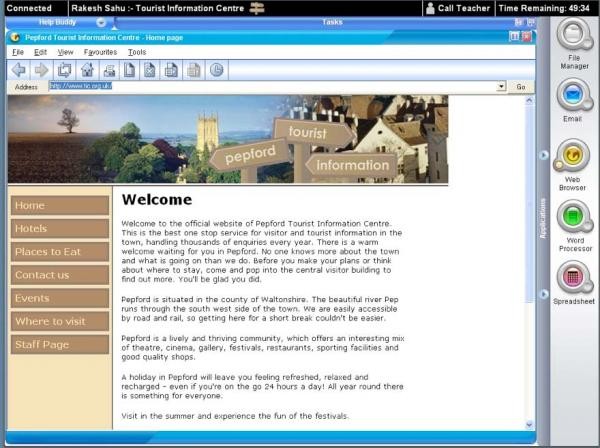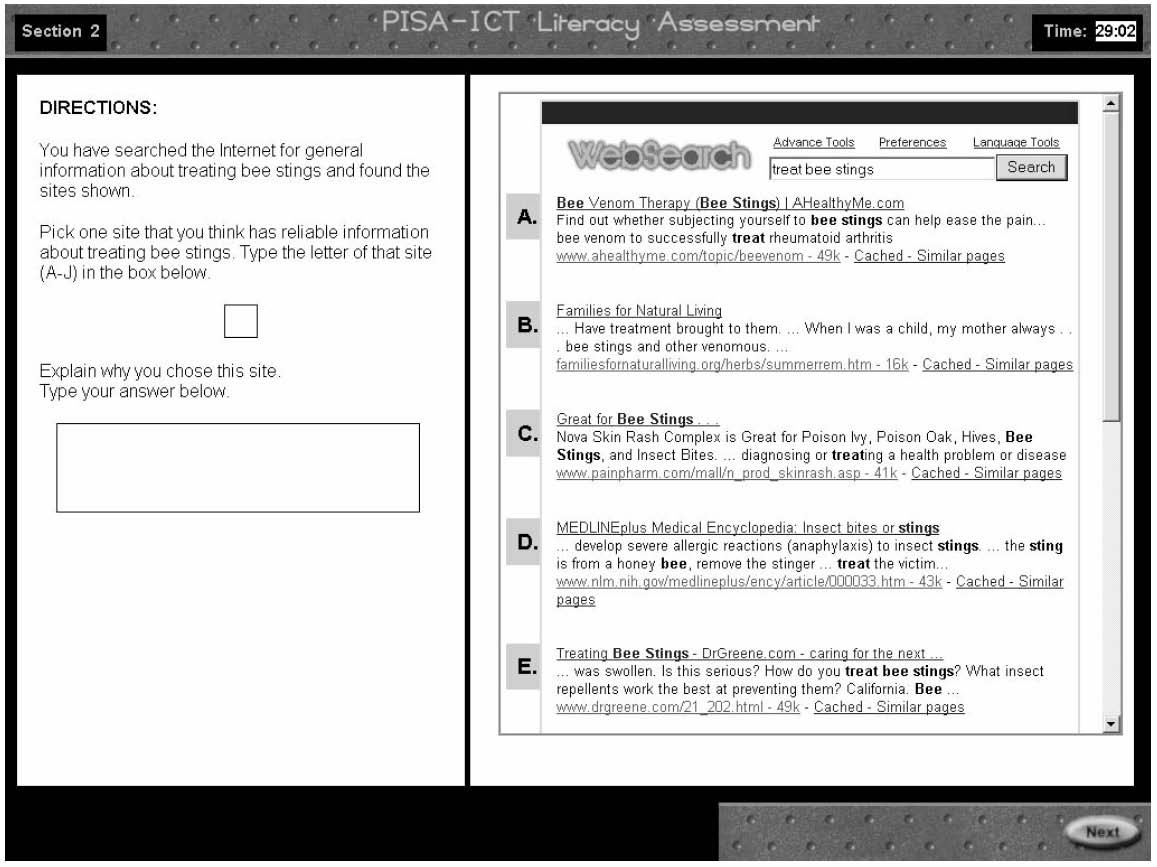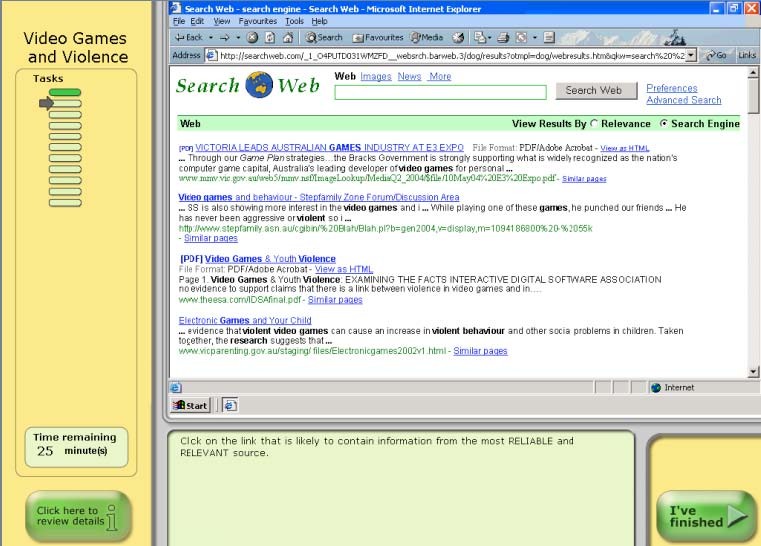Practices Applied in Information and Communication Technology (ICT)
Practices Applied in Information and Communication Technology (ICT)
ICT literacy includes the capability to communicate ideas and solutions, to collaborate with peers and experts, to conduct research, to investigate solutions to academic and real-world problems, to find ways to meet the ever-changing needs of society, to properly acknowledge the source of ideas and information, and to select and use appropriate digital tools. The sections below describe how the three practices apply to the ICT assessment targets.
Understanding Technological Principles
The principles in the ICT assessment area involve understanding the variety of ICT tools and how and when they can be used to accomplish a wide variety of tasks in school and in practical, out-of-school situations. Students will need to know about the general features and functions of types of ICT tools, which tools are appropriate for particular purposes, and to understand criteria for determining if the tools were used appropriately and well.
Developing Solutions and Achieving Goals
ICT tools can be employed to support problem solving and achievement of goals in all three of the technology and engineering literacy areas. The types of problems addressed in the ICT assessment area relate to the selection and use of appropriate tools to achieve goals related to information research, investigating problems, meeting the needs of society, constructing and exchanging information and ideas, and acknowledging ideas and information. ICT problem solving practices could be elicited by tasks and items asking students to select and use applications effectively and productively; to access and use information and data to solve a problem or achieve a goal; to use ICT tools to solve a problem or achieve a goal; or to use ICT tools to plan an approach to solving a problem, represent data, analyze results, and summarize and present findings. Students must use their understandings about the features and functions of ICT tools in order to apply the tools appropriately and effectively to develop solutions and achieve goals for given tasks and problems.
Communicating and Collaborating
ICT capabilities rely heavily on students' command of communication and collaboration skills. Students can be asked to demonstrate the capability to contribute effectively to a body of knowledge or to take part in group deliberations through social media (simulated in the assessment) and the use of other contemporary communication tools and structures. Students can be asked to investigate a problem or pursue a goal as individuals or with a group (virtually), to integrate input (provided in the task) from multiple collaborators (virtual) who are peers or experts, and to reach consensus. Students can integrate feedback from others, provide constructive criticism, and communicate to multiple audiences using a variety of media and genres. Findings can be represented in a variety of ways, such as diagrams, tables, graphs, and digital media. To communicate and collaborate effectively, students will need to use their understandings about features and functions of communication and collaboration tools and apply their knowledge and understanding of the ICT tools and strategies.
Table 3.4 provides some examples of how the 3 practices can be applied to assessment targets for Information and Communication Technologies to generate tasks and items at the middle school level. The key principles and grade 8 targets were selected from tables 2.10-2.14 in chapter two. Those tables further describe simpler targets at grade 4 or more complex targets at grade 12. These are sample ideas for items and tasks and will not be used in the actual assessment.
Table 3.4 Examples of grade 8 tasks representing practices that apply to each subarea of Information and Communication Technologies (ICT)
Practices |
|||||
|---|---|---|---|---|---|
Selected Principles |
Digital tools offer many options for formal and nonformal expression in nearly every academic and professional discipline. |
Important strategies for ensuring quality of information include 1) assessing the source of information and 2) using multiple sources to verify the information in question. Information can be distorted, exaggerated, or otherwise misrepresented. |
Digital tools can be very helpful in generating ideas and solving problems in academic subjects as well as in researching practical problems. |
There are multiple guiding principles (laws, policies, and guidelines) that govern the use of ideas and information. |
Knowledge about the common uses of readily available digital tools supports effective tool selection. |
Understanding Technological Principles |
Describe how graphics, text, and tables convey a message. |
From among a group of Web pages select the particular one that contains an example of exaggeration. |
Identify the combination of data tools that will best present a particular set of data. |
Select the example that shows an appropriate way to give credit to another student's graphic. |
Critique a digital tool suggested for designing an online story. |
Developing Solutions and Achieving Goals |
Develop an online survey for elementary school students concerning the design of a new playground. |
Create a digital story about a historical period by choosing images of art from the period. |
Use simulations and visualizations to describe the rate of deforestation in Brazil. |
Identify which online images can legally be used in a student presentation. |
Predict trends in rates of software piracy based on provided data. |
Communicating and Collaborating |
Respond to suggestions from two virtual (computer-generated) collaborators explaining why the search results of only one of the collaborators have sufficient information for the report. |
Ask a virtual collaborator for help on developing a digital presentation. |
Enter costs from several sources and communicate to the principal the most economical printer for school play posters. |
Post a copyright-free image to a website and communicate to friends that it is available. |
Use two digital tools to create a public service announcement on software piracy. |
Illustrative Tasks and Items
The following tasks and items illustrate how the three practices apply to ICT assessment targets. The practices may be elicited by extended, scenario-based task and item sets or by separate items.
Scenario-Based Item Sets
In this simulation, students navigate among a file manager, an email client, a Web browser, a word processor, and a spreadsheet to make a travel brochure for a fictional town, Pepford. They are assessed on how they use these ICT tools to accomplish the task, not on the quality of the brochure. The process is more important than the outcome. Students use the practice of Understanding Technological Principles by calling on their knowledge of which ICT tools to use to accomplish the goal and how to use them. Students also apply the practice of Developing Solutions and Achieving Goals as they conduct their information research. The practice of Communicating and Collaborating is not assessed directly in this task, although it could be added by including tasks assessing the quality of the brochure for communicating to the intended audience and tasks involving the assignment of information gathering from virtual (computer-generated) collaborators and the integration of their (virtual) input into the brochure.
Context: Travel and Tourism
Topic: Promotional Brochure
Target Level: Grade 8

Conventional Items
These items will ask for students to select or construct their answers. The examples below are of the familiar constructed and selected response formats.
Constructed and Selected Response
In this task, students are presented with a list of websites from the results of a Web search. Students must decide which website has the most reliable information and justify their response. The practice of Understanding Technological Principles is applied to students' knowledge of criteria for how to judge the credibility and quality of information sources—one of the ICT targets in Information Research.
Context: Medicine
Topic: Web Search
Target Level: Grade 8

Selected Response Multiple Choice
This multiple choice item also assesses a student's capability to evaluate websites, an example of the practice Understanding Technological Principles. This example also demonstrates a computer-based selected response format.
Context: The Internet
Topic: Website Search
Target Level: Grade 12
Watch a video clip of this item
